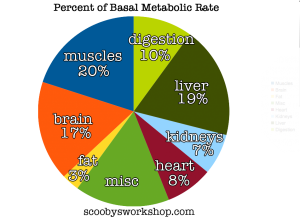Metabolic Damage
Metabolic Damage is real, but its not what you think, and its nothing mysterious. Metabolic damage is easy to avoid and but harder to recover from.
What Is Metabolic Damage
Metabolic damage is damage to the body which significantly lowers your Basal Metabolic Rate, that is, the number of calories expended when you are doing nothing. If metabolic damage lowers your BMR then you are likely to start gaining fat and losing fat becomes very difficult.
What Causes Metabolic Damage
It is truly damage, damage which is caused by stupidity, haste, and impatience. Many fad diets and extreme diets cause metabolic damage. This damage can take many months of hard work to recover from so its best if you avoid metabolic damage in the first place.
Metabolism 101
A human body is a machine and all machines require energy to operate. Smaller machines (kids) require a lot less energy than big machines (Arnold Schwarzenegger). Even when we “do nothing” we require a lot of energy to live, this is called the Basal Metabolic Rate or BMR. The BMR is the energy to keep body temperature up, pump blood, breathe, and other basic housekeeping functions. The Total Daily Energy Expenditure (TDEE) is the BMR plus the work done by walking, running, moving, thinking, and lifting weights. If someone is sedentary, about 70% of the TDEE will be the BMR which means that basically all the food eaten is simply being used to keep the body alive. On the other hand, if someone is very physically active, the BMR will only be about 40% of the TDEE which basically means that the food eaten is being used to do work rather than to just keep the body alive.
Some parts of the body are a lot more expensive, energy wise, to operate than others. Surprisingly, the brain is very expensive to operate and uses about 17% of all you eat. Even things we consider mindless, like watching TV, kick the brain into high gear and burn the calories. BTW, if *anyone* suggests TV watching to lose fat I will do an epic pillow-scream! Breathing, digesting, maintaining body temperature, and pumping blood takes a big chunk too which is not too surprising. Then there is the cellular maintenance, the daily cellular repairs that have to be made to every cell in the body. Not too surprisingly, fat cells need almost no maintenance and they consume less than 3% of what you eat. Muscle cells on the other hand are, require a LOT of energy to maintain because they are constantly getting damaged from lifting and doing work. Even in the average sedentary DYEL, maintaining the muscle requires 20% of all you eat. For people who use their muscles a lot, and damage them, the energy required to maintain them will be even larger.
I didn’t tell you all this stuff just to look smart. I am NOT smart, I had to look all those numbers up. There is a point to this and it has to do with metabolic damage. So look at the above pie chart which shows how much of our BMR comes from various parts of the body. The brain uses a lot of energy but there is really not a lot you can do to make it bigger. Your liver and kidneys use a lot of energy but there is not a lot you can do to make them bigger or use more energy either. There ARE two things that you CAN make bigger though and that is your fat stores and your muscle mass. In an average person, cellular maintenance of the fat deposits require about 3% of the energy. To increase your BMR, you could add a bunch of fat! This indeed works but its a very bad idea health wise, and also logically. Fat is very cheap in a metabolic sense as it takes hardly any energy (food) to maintain it. You have to add a LOT of fat to significantly increase your BMR. Muscle mass is another story entirely. Not only is muscle mass a lot denser than fat but its a lot more useful. Useful both in terms of everyday life but much, much more useful in raising the BMR. Even in a sedentary person who does not lift weights, muscle burns 20% of the food eaten. To increase your BMR, you could add a bunch of muscle! This does indeed work. Bodybuilders with large amounts of muscle mass have incredible caloric intake requirements. Trouble is, adding muscle requires a lot more work to add than fat does. Maybe its not worth the work to you to *add* muscle but you can at least make sure you do not LOSE it. You do not want to lose muscle because it will significantly lower your BMR and make it harder to lose fat and keep it off!
The point of this is that muscles are VERY expensive in a metabolic sense, they require a LOT of energy (aka FOOD) to maintain even when you never use them.
What Causes Metabolic Damage
So lets try this again. What causes metabolic damage? Bad nutritional plans in the form of fad diets, and extreme diets cause metabolic damage! More specifically, these nutritional mistakes cause you to lose muscle mass which significantly lowers your BMR and “damages” your metabolism. When you do not get enough protein or sufficient calories, your body will cannibalize the muscles in the body for energy. Impatience causes metabolic damage. It took years to gain all that fat and rushing to get it off FAST will burn off muscle as well. In all my meal planners, 25% is the maximum amount I allow people to restrict their calories because in my view, any more than that risks losing muscle mass. Many of the extreme dieters cut their calories by 50% to 75% which is crazy talk. I just want to scream at these folks that weight loss is not the same thing as fat loss. When they lose 10 pounds in a week, a big chunk of that is muscle loss. Muscle is the most important ally in these peoples fat loss program and they are willfully throwing it away! Stupid diets cause metabolic damage!
Starvation Mode Is Real
Starvation mode is real, its not a myth. Fortunately, starvation mode is something that is fairly rare and is limited to famine victims and those with mental diseases like anorexia, but if you cut your calories too drastically for too long, some very serious changes take place in your body. In post World War II Europe and Asia, America was very concerned about widespread famine and what best could be done to combat it so a very famous “Minnesota Starvation Experiment” was undertaken to scientifically look at what happens during starvation and how best to combat it. Here is one of the relevant conclusions of the study that is relevant to this discussion of metabolic damage:
There were marked declines in physiological processes indicative of decreases in each subject’s basal metabolic rate, reflected in reduced body temperature, respiration and heart rate.
In other words, your body DOES enter into a “starvation mode” to conserve energy when insufficient food is available – as close as humans can get to hibernation. This is NOT a mode you ever want to be in, physically or mentally. If you want to be scared away from drastic diets, read the full report on the experiment. The mental aspects of the starvation where the most alarming in my opinion. Self mutilation, depression, social withdrawal and isolation as well as food issues and mental scarring that stayed with people the rest of their lives. Depriving humans of food causes all kinds of lifelong mental issues which is why I always say that if you are ever hungry when you are cutting, you are doing something very, very wrong.
How Do You Prevent Metabolic Damage?
Easy! Use a sensible weight loss nutritional plan instead of drastic or fad diets! Limit calories by no more than 25% and make sure to get sufficient protein. I strongly suggest you use my custom meal planner for at least one week to train your eye and stomach as to the proper foods and portion sizes that you need. There is little margin for error here. To drastic a caloric restriction and you lose muscle. Not enough caloric restriction and you don’t lose the fat. A very narrow line to walk indeed which is why at least for the first week, I want you to weigh and measure everything you eat or drink! No eyeballing it allowed because even I cannot guess portion sizes with sufficient accuracy to get a constant 25% caloric deficit. If you are used to tasty junk food, this will be a very difficult week for you indeed but stick it out. The foods in custom meal planner are all unprocessed healthy foods and you will need to develop a taste for them. Vegetables and fruits can be tasty but it takes a bit of time to appreciate them.
How Do You Cure Metabolic Damage?
OK, so you did an extreme diet lost over a hundred pounds and then googled to find this article because you have metabolic damage. Well, now you know how to prevent it from happening again but that doesn’t help your current situation. Curing metabolic damage is straightforward but requires a lot of work … or should I say, working out. The cure for metabolic damage is to do resistance training to build the muscle back. Here are some suggestions of the best workout plan for you. To cure metabolic damage requires re-gaining muscle mass you lost with your extreme diet and even adding some more. The good news is that muscle mass lost thru extreme diets will come back much more quickly than it took to add the muscle initially. In three to six months of a consist resistance training program you should be right back where you were muscle mass wise and metabolic wise. Why stop there though? Every little bit of muscle you add is that much more food you can enjoy eating without gaining any fat!


